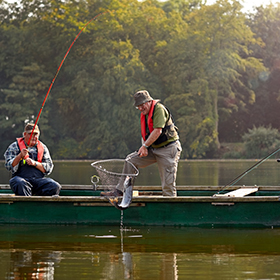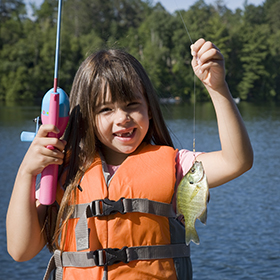There are three main types of fishing reels. How to choose a fishing reel depends partially on what you like to catch and how you like to catch them.
There are three main types of fishing reels, with many choices within each design. In theory at least, any fishing reel can catch any fish; it is just that some reels are more proficient in certain areas. To help decide how to choose a fishing reel, consider what you like to catch and how you like to catch ‘em.
For example, it is a good idea for young or novice anglers to start with a push-button, closed-face, spin-cast reel. This type of fishing reel is a great confidence builder because it is so simple and provides a lot of control. Although there are large, rugged versions available for sizeable catfish, many closed-face reel users target smaller species such as sunfish. Until the introduction of “super lines,” some Bassmaster elite tournament anglers used this type of fishing reel for better control to make certain casts like skipping under docks.
As fishing skill increases, the next reel to choose is a spinning reel. For making accurate casts, there is a little less control with this fishing reel and it requires more hand, finger use to operate but it is versatile and very user-friendly. Spinning reels range from ultra light versions for ice fishing to heavy saltwater models to battle whoppers from the deep.
The baitcaster is the third main type of fishing reel. Many bass anglers find it perfectly suited for the techniques of “flipping” or “pitching,” which are relatively close casts, usually with a heavy jig. With a great deal of practice, baitcasters are fun for long casts with other lures too. However, with every cast of this reel you risk the dreaded “bird’s nest.” Even professional bass anglers need to adjust the reel with every lure switch and must have a well-trained thumb to slow the spool at the end of a cast.
For the best all-around fishing gear, I recommend a medium spinning reel. It can cast a wide range of lures or bait without adjustment and handle just about anything that swims. When shopping, consider the number of ball bearings of the reel. A little extra cost usually means a smoother, longer-lasting reel. But make sure you brought enough for that renewed fishing license. Priorities!
For example, it is a good idea for young or novice anglers to start with a push-button, closed-face, spin-cast reel. This type of fishing reel is a great confidence builder because it is so simple and provides a lot of control. Although there are large, rugged versions available for sizeable catfish, many closed-face reel users target smaller species such as sunfish. Until the introduction of “super lines,” some Bassmaster elite tournament anglers used this type of fishing reel for better control to make certain casts like skipping under docks.
As fishing skill increases, the next reel to choose is a spinning reel. For making accurate casts, there is a little less control with this fishing reel and it requires more hand, finger use to operate but it is versatile and very user-friendly. Spinning reels range from ultra light versions for ice fishing to heavy saltwater models to battle whoppers from the deep.
The baitcaster is the third main type of fishing reel. Many bass anglers find it perfectly suited for the techniques of “flipping” or “pitching,” which are relatively close casts, usually with a heavy jig. With a great deal of practice, baitcasters are fun for long casts with other lures too. However, with every cast of this reel you risk the dreaded “bird’s nest.” Even professional bass anglers need to adjust the reel with every lure switch and must have a well-trained thumb to slow the spool at the end of a cast.
For the best all-around fishing gear, I recommend a medium spinning reel. It can cast a wide range of lures or bait without adjustment and handle just about anything that swims. When shopping, consider the number of ball bearings of the reel. A little extra cost usually means a smoother, longer-lasting reel. But make sure you brought enough for that renewed fishing license. Priorities!









